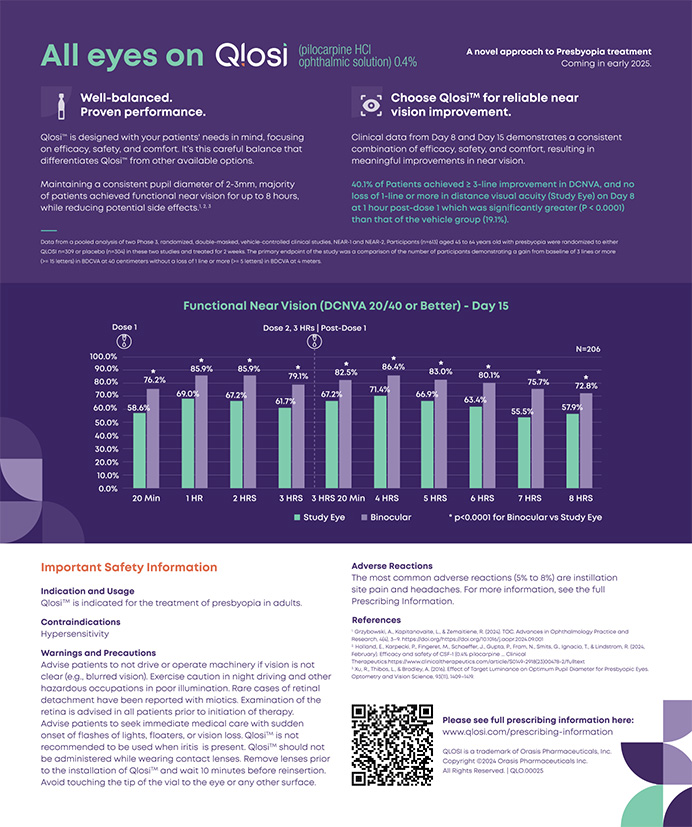Intracorneal ring segments (ICRSs) have been used for more than 15 years in keratoconic eyes to reshape the cornea, reduce corneal steepening and refractive error, and avoid or delay the need for a corneal transplant.
One type of ICRS is Intacs (Addition Technology), which were developed to treat low degrees of myopia in patients with healthy eyes and were later used in patients with keratoconus. Intacs have been implanted in patients with a 7-mm optical zone diameter, yielding positive results treating this ectatic disease. Intacs were later developed for a 6-mm-diameter optical zone (Intacs SK) for advanced keratoconus. The initial Intacs SK design comprised segments of a 150º arc length; now available are segments with arc lengths of 90º, 130º, and 210º.1 This offers greater possibilities for treating myopia and astigmatism in patients with keratoconus and other ectatic disorders. Although the new Intacs SK have not yet been approved by the FDA, they recently received CE Mark approval.
INTRACORNEAL RING SEGMENTS OF 210º ARC LENGTH
In 2013, my colleague and I reported the first post-LASIK ectasia case treated with an Intacs SK 210º arc using the new nomogram of Intacs (version 3.1), in which this type of segment is also used to treat patients with decentered keratoconus.2 These four parameter should be followed to implant these ICRSs:
1. A topographic shape pattern with inferior steepening in the axial or sagittal map.
2. A decentered cone, with most of its area of major power contained outside the central topography’s 3-mm zone; this is seen in the tangential or curvature map.
3. Refractive astigmatism should not be greater than -3.00 D, and myopia should not be greater than -3.00 D.
4. The segment should be implanted in a 7-mm tunnel (Figure 1).
Also available are Ferrara rings (Ferrara Ophthalmics) with 210º of arc length in the central 5 mm to be used on eyes with nipple-type keratoconus1 and the Keraring ICRS (Mediphacos), which uses a 210º arc segment in 5 mm in the management of pellucid marginal corneal degeneration in patients with myopia of up to -7.00 D and astigmatism of up to -8.50 D.3
OUR CASE SERIES
We used Intacs SK 210º arc length in a case series of patients with decentered keratoconus and post-LASIK ectasia. We measured the results using uncorrected distance visual acuity, corrected distance visual acuity, and manifest spherical and cylindrical refraction. Using the Galilei Dual Scheimpflug Analyzer (Ziemer Ophthalmic Systems), we evaluated the maximum keratometry (Kmax), minimum keratometry, and corneal vertical coma aberration.
RESULTS
The uncorrected and corrected distance visual acuity improved from 0.57 LogMAR (0.22/0.92) to 0.26 LogMAR (0.09/0.42) and from 0.16 LogMAR (0.07/0.24) to 0.10 LogMAR (-0.01/0.21), respectively. As we have seen in most cases with different arc lengths of Intacs, there was also a hyperopic shift in the current case series from -0.25 D (-2.41/1.91) preoperatively to 1.00 D (0.14 /1.94) postoperatively.
In ectasia cases where the steepest corneal zone is contained outside the central 3 mm, the simulated keratometry is not useful as a follow-up variable. The K(max) became a good measurement to use, as others have done to evaluate postoperative outcomes.4,5
Because it is very important to avoid bias in the K(max) value, we used the alignment parameters from the Galilei tomographer and the x, y Cartesian coordinate system to locate this variable at the same point in the axial map when we compared pre- and postoperative images (Figure 2).
In these procedures, we are always looking to achieve an even corneal surface. What we found in this case was a local flattening with a decrease in the K(max) and a mild increase in the minimum keratometry, obtaining a bit smoother corneal surface (Table). Another way to see this effect is through the vertical coma, which also had a reduction of 35% between the pre- and postoperative data as shown in the Table.
CONCLUSION
Clinically, decentered keratoconus and post-LASIK ectasia with low refractive errors respond well to Intacs with 210º arc length, achieving a more even surface, which leads to better visual acuity and, ultimately, a better quality of life for our patients.
Section Editor George O. Waring IV, MD, is the director of refractive surgery and an assistant professor of ophthalmology at the Storm Eye Institute, Medical University of South Carolina. He is also the medical director of the Magill Vision Center in Mt. Pleasant, South Carolina. Dr. Waring may be reached at waringg@musc.edu.
Claudia Blanco, MD, is a cornea and refractive surgery subspecialty ophthalmologist in the Cornea and Refractive Surgery Unit at the Clínica de Oftalmología de Cali, Colombia. She acknowledged no financial interest in the products or companies mentioned herein. Dr. Blanco may be reached at +011 57 2 5110293; claudia@visionsana.com.
- Ferrara P, Torquetti L. Clinical outcomes after implantation of a new intrastromal corneal ring with a 210-degree arc length. J Cataract Refract Surg. 2009;35:1604-1608.
- Nunez MX, Blanco C. Intacs 210° in post-Lasik ectasia: follow-up of clinical and biomechanical changes. Int J Kerat Ect Cor Dis. 2013;2(2):89-91.
- Kubaloglu A, Sogutlu Sari E, Cinar Y, Koytak A, et al. Single 210-degree arc length intrastromal corneal ring implantation for the management of pellucid marginal corneal degeneration. Am J Ophthalmol. 2010;150:185- 192.
- Richoz O, Mavrakanas N, Pajic B, Hafezi F. Corneal collagen cross-linking for ectasia after LASIK and photorefractive keratectomy: long-term results. Ophthalmology. 2013;120(7):1354-1359.
- Hashemi H, Seyedian MA, Miraftab M, Fotouhi A. Corneal collagen cross-linking with riboflavin and ultraviolet a irradiation for keratoconus: long-term results. Ophthalmology. 2013;120(8):1515-1520.


